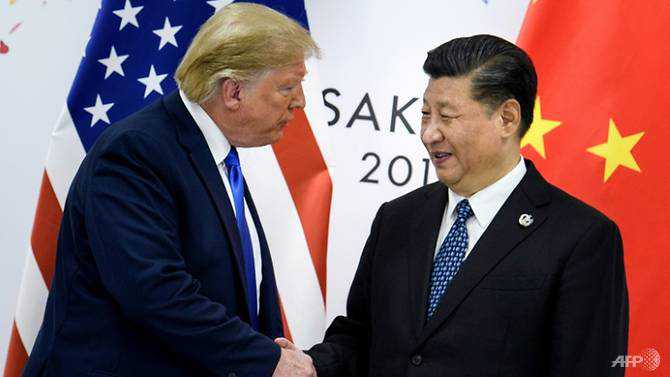US-China 'phase one' trade deal to be signed on Jan 15
01 January, 2020

A partial new US-China trade agreement will be signed in the middle of next month, US President Donald Trump said on Tuesday (Dec 31), announcing that he will also then travel to China for continued talks.
Trump's tweet, sent moments before Wall Street opened for the year's final trading day, set a calendar date for an event that had hung in uncertainty in recent weeks as details remained scant.
Washington and Beijing earlier this month announced a "Phase One" trade deal, de-escalating their nearly two-year trade war as Trump reduced or canceled some tariffs while Beijing promised to adopt trade reforms and buy more US farm exports.
The text has yet to be made public pending what US officials say is a largely technical review.
"I will be signing our very large and comprehensive Phase One Trade Deal with China on January 15," Trump tweeted moments before Wall Street was due to open.
"The ceremony will take place at the White House. High level representatives of China will be present."
US and Chinese officials have said the agreement includes protections for intellectual property, food and farm goods, financial services and foreign exchange, and a provision for dispute resolution.
Under the new deal, China has committed to a minimum of US$200 billion in increased purchases over the next two years from US manufacturers, farmers, energy producers and service providers, according to US Trade Representative Robert Lighthizer.
ON TO PHASE TWO?
Trump said on Tuesday he will travel to Beijing to continue negotiations "at a later date" - showing willingness to pursue talks that have acrimoniously broken down more than once and left both sides to salvage a partial deal.
While the detente put a stop to further deterioration in the trade war, it leaves many of the barriers erected so far in place.
Trump cancelled plans to impose tariffs on US$160 billion in Chinese merchandise in mid-December - including hot consumer items like mobile phones - but punishing US tariffs remain for about US$250 billion in Chinese-made goods, including machinery and many electronic items.
Word of the truce has driven a Wall Street rally this month and US stocks on Tuesday closed out the year with their best annual performances since 2013.
The two economic powers have been locked in a bruising trade war since the first half of 2018 that has roiled the global economy and helped send the manufacturing sector into decline.
The two economic powers have been locked in a bruising trade war since the first half of 2018 that has roiled the global economy and helped send the manufacturing sector into decline.
Observers say that in that time, the trade war may have ushered in a long-term de-coupling of trade relations between the world's two largest economies.
Americans have cut merchandise purchases from China substantially so far this year, while their appetite for Mexican goods has grown.
The yawning US goods deficit with China fell 14.7 per cent in the 10 months through October of 2019 but rose 29 per cent with Mexico, according to official US figures.
What the two sides can accomplish in a potentially thornier "phase two" of negotiations - which could touch on Beijing's sweeping market interventions and industrial subsidies - remains unclear.
Trump has repeatedly claimed the trade war's burden fell squarely on China, while sparing the American economy. Economists say both sides have suffered.
But the United States appears to have emerged from an earlier recession scare as Beijing has moved to reverse a worrisome slowdown.
Still, some economists and trade experts say Phase One was largely a victory for Beijing.
Scott Paul, president of the Alliance for American Manufacturing, which has largely favoured Trump's aggressive trade posture with China, said earlier that agreeing to remove tariffs amounted to "giving away much of our leverage, while kicking the can down the road on the most meaningful trade issues with China."
The truce also offers Chinese President Xi Jinping breathing space as he faces a slowing economy and political trouble in Hong Kong.
Peter Navarro, White House director of trade and manufacturing policy, told CNBC on Tuesday that the Phase One agreement was only one plank in the Trump trade agenda, which encompasses other newly negotiated agreements in North America and Asia.
"Next year ... we're going to try to get something going with Great Britain, Vietnam, Europe and anybody else who wants to fairly trade with the United States," he said.
Source:
